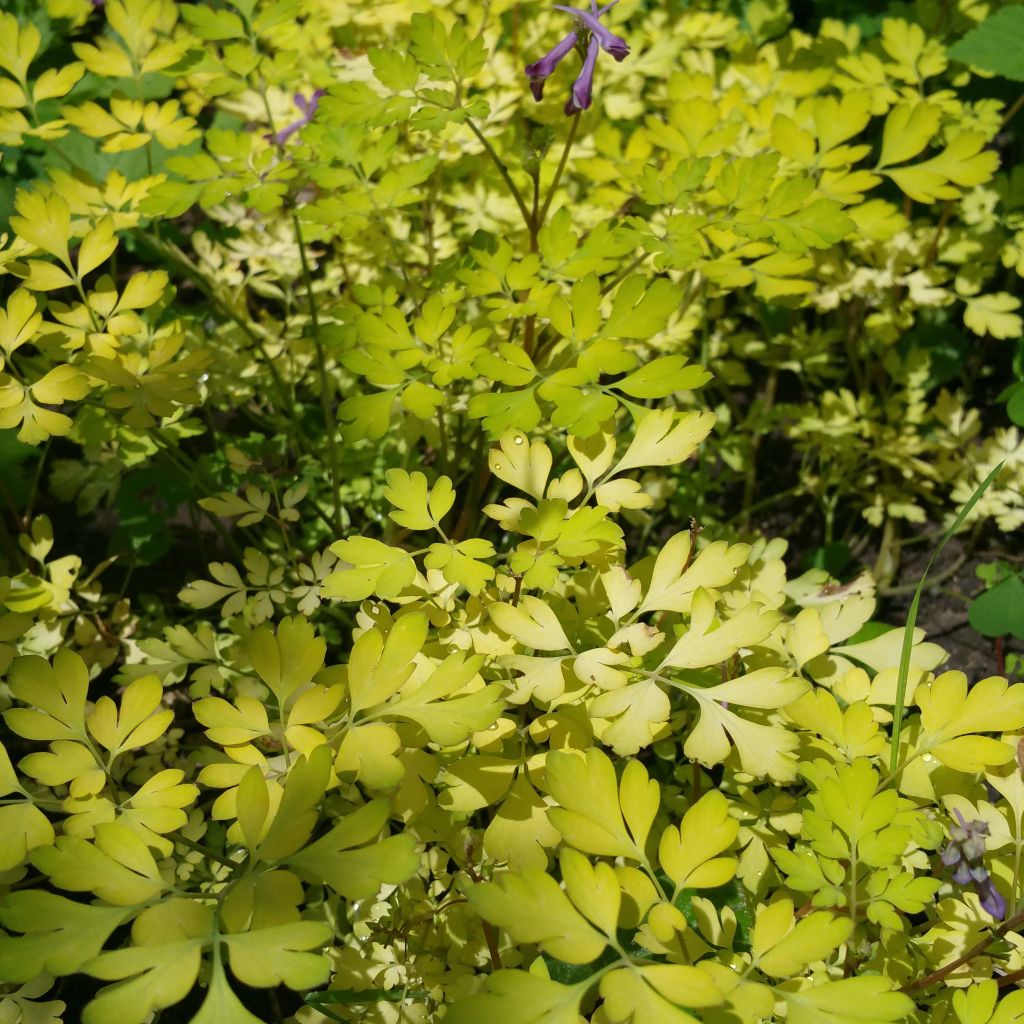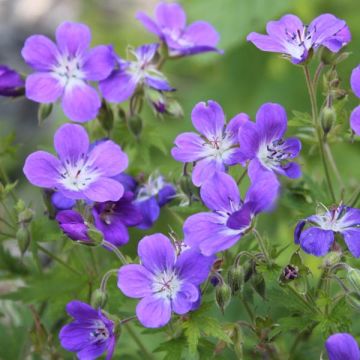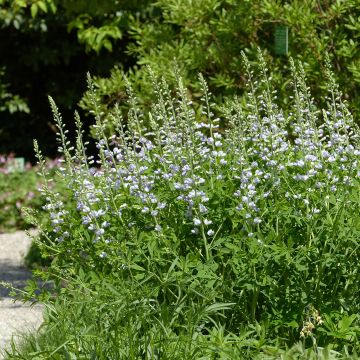

Corydalis Berry Exciting - Corydale hybride


Corydalis Berry Exciting - Corydale hybride
Corydalis Berry Exciting - Hybrid Corydalis
Corydalis Berry Exciting
Fumewort
This item cannot be shipped to the selected country
Delivery charge from €5.90
More information
Schedule delivery date,
and select date in basket
This plant carries a 12 months recovery warranty
More information
We guarantee the quality of our plants for a full growing cycle, and will replace at our expense any plant that fails to recover under normal climatic and planting conditions.
From €5.90 for pickup delivery and €6.90 for home delivery
Express home delivery from €8.90.
Does this plant fit my garden?
Set up your Plantfit profile →
Description
The Corydalis 'Berry Exiting' is undoubtedly one of the most amazing hybrids born from the marriage of these perennial plants from China. Flowers in long purple tubes emerging from variegated golden fern foliage create a striking contrast in shaded and cool areas where it will thrive. In addition to its undeniable aesthetic qualities, this corydalis offers ease of cultivation that allows for numerous uses, from ground cover to hanging baskets, and even covering shaded walls.
The hybrid Corydale 'Berry Exciting' is a natural mutation of the variety 'Blackberry Wine', acclaimed for its countless qualities. It was introduced by Terra Nova Nurseries (USA) in 2007. Like all Corydalises, it belongs to the family Fumariaceae. The relatively slow growth of this corydalis allows it to occupy about 45 cm (18in) in width, with a height of 30 cm (12in). It forms a compact and dense clump, slowly spreading as a ground cover thanks to its stolons. The foliage, carried by reddish stems, has a beautiful hue, blending pale golden yellow and chartreuse green. Finely cut, it resembles that of bleeding hearts, fumitories, ferns, or chervil. The flowering period is surprisingly long, and according to some, fragrant. It begins in May and continues until the end of summer in cool climates. In warmer climates, the plant tends to go dormant in summer and re-blooms in autumn. The flowers, resembling small tubes about 2.5 cm (1in) in length, have a long spur. Each flower has areas that take on different shades of purple and crimson, with bluish highlights. It is this subtle range of colours, painted on translucent petals, that gives the flowering its luminous and distinctive colour. The vegetation of this corydalis remain evegreen in winter, depending on the intensity of the cold.
Corydalis is primarily a shade plant, or a part-shade plant that expresses its full potential in cool woodland areas. It can be associated with other perennials that are not afraid of competition from tree or shrub roots. Accompany it with the cousin of Solomon's Seal called Uvularia grandiflora, hardy fuchsias, creeping purple bugles, Omphalodes verna, Japanese anemones, Tricyrtis, and a carpet of small periwinkles, or even the 'Ivory Heart' Bleeding Heart. This plant also performs well in pots and creates a beautiful effect in hanging baskets where it cascades down. Plant this corydalis above walls, on the north side, or in shady rockeries.
Report an error about the product description
Corydalis Berry Exciting - Hybrid Corydalis in pictures




Flowering
Foliage
Plant habit
Botanical data
Corydalis
Berry Exciting
Fumariaceae - Papaveraceae
Fumewort
Cultivar or hybrid
Other Corydalis
Planting and care
Plant the 'Berry Exciting' hybrid Corydalis in deep, light and humus-rich soil that remains consistently moist, neutral to acidic, or at least free from excessive limestone. It tolerates clay soils well if they are lightened with compost and therefore well-drained. It will thrive in shade or a partially shaded position in the morning sun, under trees or bushes with which it does not compete. Clean the plant in spring to remove dead foliage.
Planting period
Intended location
Care
This item has not been reviewed yet - be the first to leave a review about it.
Spring flowering perennials
Haven't found what you were looking for?
Hardiness is the lowest winter temperature a plant can endure without suffering serious damage or even dying. However, hardiness is affected by location (a sheltered area, such as a patio), protection (winter cover) and soil type (hardiness is improved by well-drained soil).

Photo Sharing Terms & Conditions
In order to encourage gardeners to interact and share their experiences, Promesse de fleurs offers various media enabling content to be uploaded onto its Site - in particular via the ‘Photo sharing’ module.
The User agrees to refrain from:
- Posting any content that is illegal, prejudicial, insulting, racist, inciteful to hatred, revisionist, contrary to public decency, that infringes on privacy or on the privacy rights of third parties, in particular the publicity rights of persons and goods, intellectual property rights, or the right to privacy.
- Submitting content on behalf of a third party;
- Impersonate the identity of a third party and/or publish any personal information about a third party;
In general, the User undertakes to refrain from any unethical behaviour.
All Content (in particular text, comments, files, images, photos, videos, creative works, etc.), which may be subject to property or intellectual property rights, image or other private rights, shall remain the property of the User, subject to the limited rights granted by the terms of the licence granted by Promesse de fleurs as stated below. Users are at liberty to publish or not to publish such Content on the Site, notably via the ‘Photo Sharing’ facility, and accept that this Content shall be made public and freely accessible, notably on the Internet.
Users further acknowledge, undertake to have ,and guarantee that they hold all necessary rights and permissions to publish such material on the Site, in particular with regard to the legislation in force pertaining to any privacy, property, intellectual property, image, or contractual rights, or rights of any other nature. By publishing such Content on the Site, Users acknowledge accepting full liability as publishers of the Content within the meaning of the law, and grant Promesse de fleurs, free of charge, an inclusive, worldwide licence for the said Content for the entire duration of its publication, including all reproduction, representation, up/downloading, displaying, performing, transmission, and storage rights.
Users also grant permission for their name to be linked to the Content and accept that this link may not always be made available.
By engaging in posting material, Users consent to their Content becoming automatically accessible on the Internet, in particular on other sites and/or blogs and/or web pages of the Promesse de fleurs site, including in particular social pages and the Promesse de fleurs catalogue.
Users may secure the removal of entrusted content free of charge by issuing a simple request via our contact form.
The flowering period indicated on our website applies to countries and regions located in USDA zone 8 (France, the United Kingdom, Ireland, the Netherlands, etc.)
It will vary according to where you live:
- In zones 9 to 10 (Italy, Spain, Greece, etc.), flowering will occur about 2 to 4 weeks earlier.
- In zones 6 to 7 (Germany, Poland, Slovenia, and lower mountainous regions), flowering will be delayed by 2 to 3 weeks.
- In zone 5 (Central Europe, Scandinavia), blooming will be delayed by 3 to 5 weeks.
In temperate climates, pruning of spring-flowering shrubs (forsythia, spireas, etc.) should be done just after flowering.
Pruning of summer-flowering shrubs (Indian Lilac, Perovskia, etc.) can be done in winter or spring.
In cold regions as well as with frost-sensitive plants, avoid pruning too early when severe frosts may still occur.
The planting period indicated on our website applies to countries and regions located in USDA zone 8 (France, United Kingdom, Ireland, Netherlands).
It will vary according to where you live:
- In Mediterranean zones (Marseille, Madrid, Milan, etc.), autumn and winter are the best planting periods.
- In continental zones (Strasbourg, Munich, Vienna, etc.), delay planting by 2 to 3 weeks in spring and bring it forward by 2 to 4 weeks in autumn.
- In mountainous regions (the Alps, Pyrenees, Carpathians, etc.), it is best to plant in late spring (May-June) or late summer (August-September).
The harvesting period indicated on our website applies to countries and regions in USDA zone 8 (France, England, Ireland, the Netherlands).
In colder areas (Scandinavia, Poland, Austria...) fruit and vegetable harvests are likely to be delayed by 3-4 weeks.
In warmer areas (Italy, Spain, Greece, etc.), harvesting will probably take place earlier, depending on weather conditions.
The sowing periods indicated on our website apply to countries and regions within USDA Zone 8 (France, UK, Ireland, Netherlands).
In colder areas (Scandinavia, Poland, Austria...), delay any outdoor sowing by 3-4 weeks, or sow under glass.
In warmer climes (Italy, Spain, Greece, etc.), bring outdoor sowing forward by a few weeks.


















































